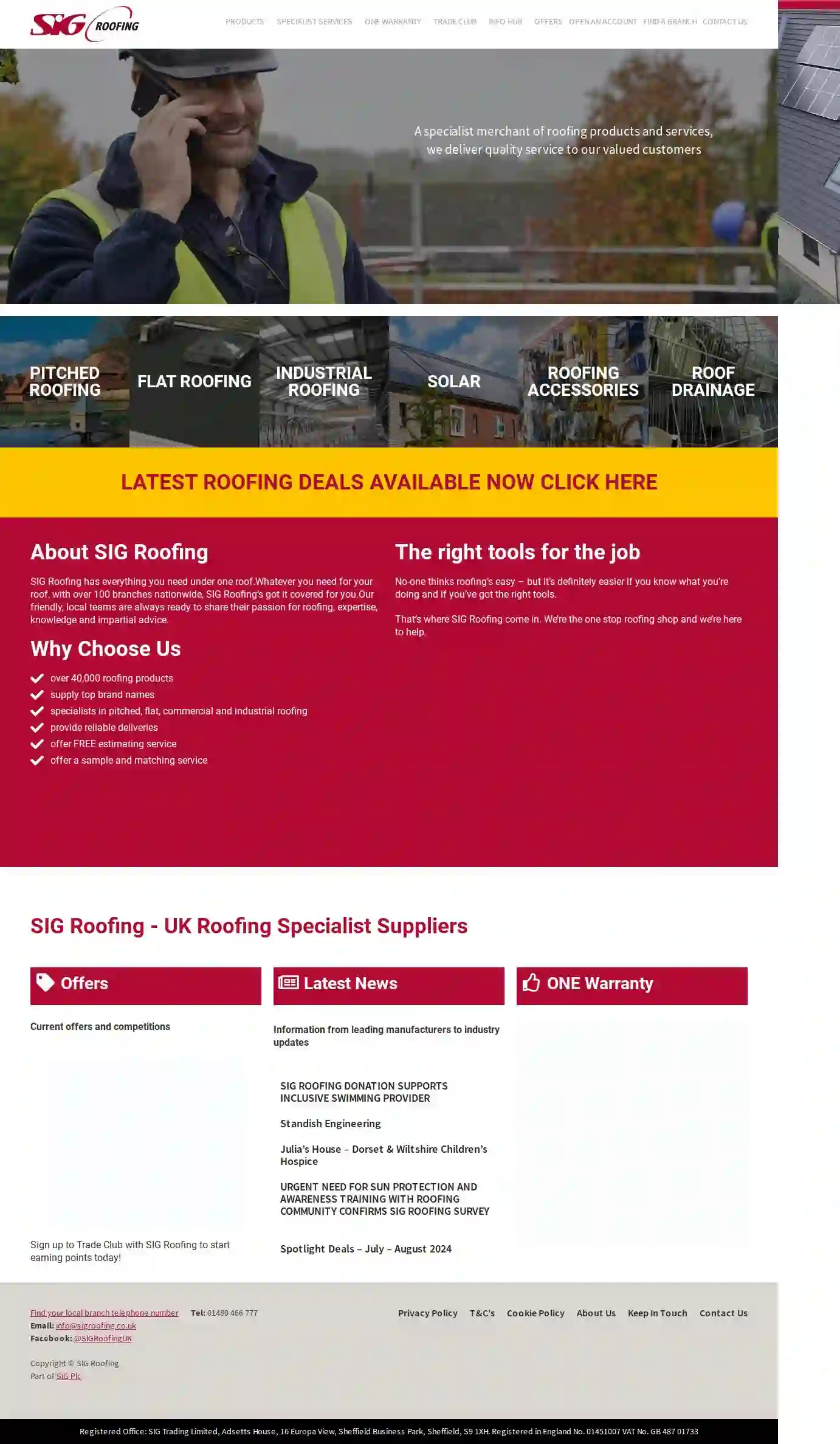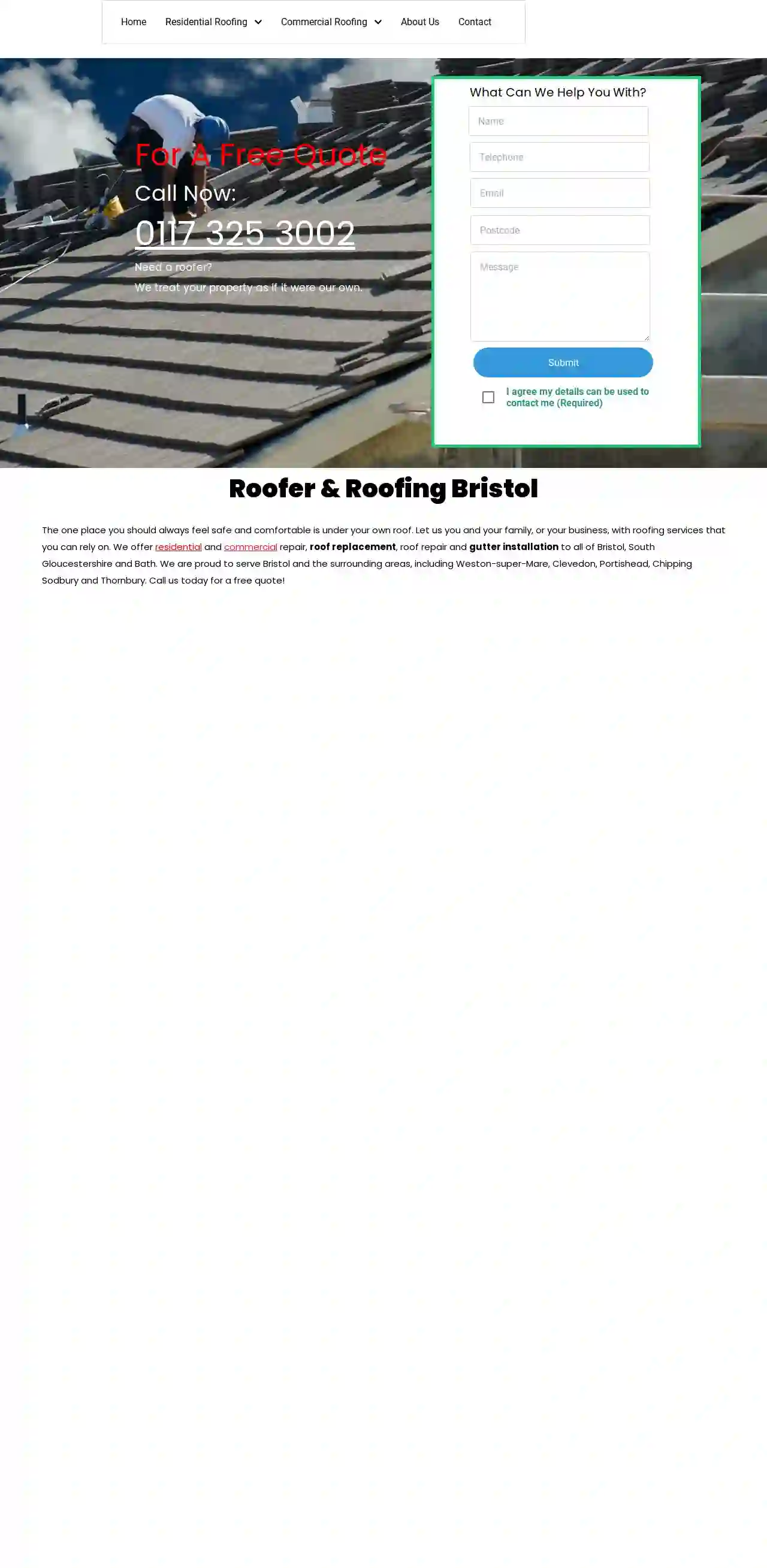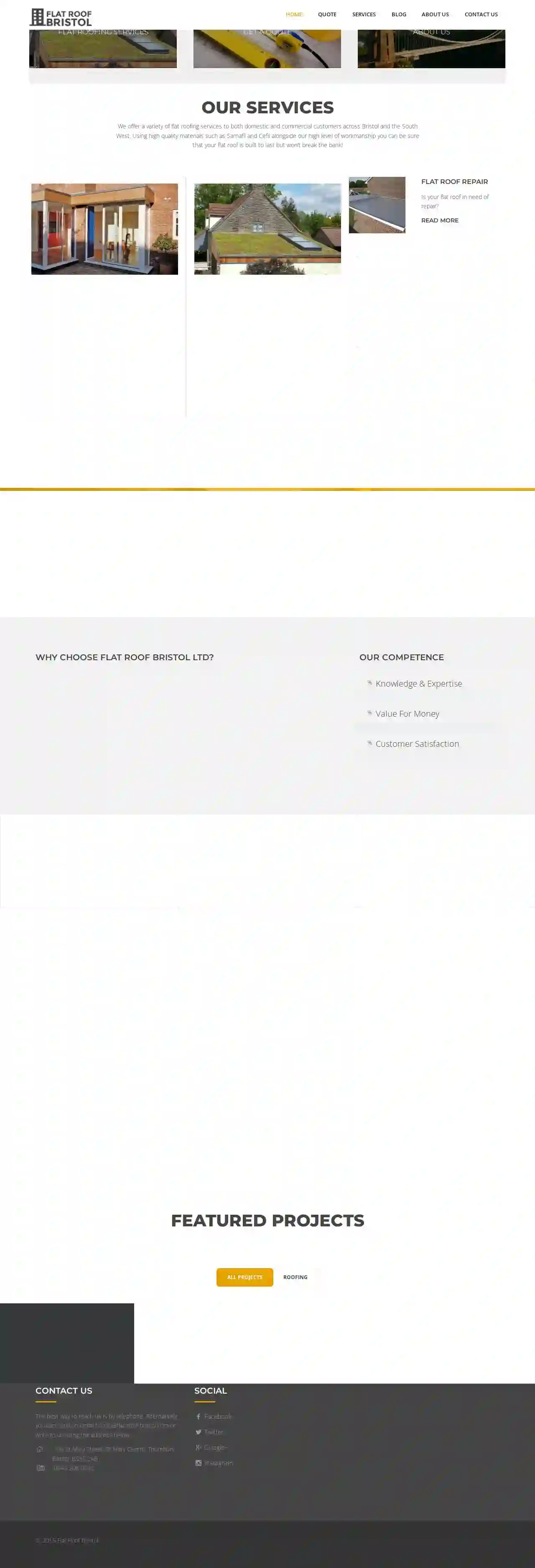Roofing Companies Yatton
Top Roofing Contractor in Yatton
Receive multiple Roofing Service quotes for your project today! Compare profiles, reviews, accreditations, portfolio, etc... and choose the best offer.

Bristol Caribbean Roofing & Carpentry Ltd.
55 reviewsBristol, BS8 4RJ, GBBristol Caribbean Roofing & Carpentry Ltd is a company dedicated to providing high-quality roofing and carpentry services in Bristol. With experience gained in France and the Caribbean, we bring a unique approach and expertise to every project. We specialize in roof renovations, repairs, and installations, ensuring your roof is a reliable defense against the elements. Whether you need leak repairs, valley and gutter restoration, or a complete roof replacement, our team is here to help. We also offer a range of carpentry services, including loft conversions, home extensions, and interior fittings. At Bristol Caribbean Roofing & Carpentry Ltd, we prioritize customer satisfaction and strive to deliver exceptional results. We guide you through the best options for your needs, ensuring you feel comfortable with your choices. Our commitment to quality craftsmanship and attention to detail sets us apart. Contact us today for a free consultation and let us help you with your next roofing or carpentry project.
- Services
- Why Us?
- Gallery
Get Quote
SIG Roofing Bristol Barton Hill
4.147 reviewsBristol, GBSIG Roofing is a specialist merchant of roofing products and services, delivering quality service to our valued customers. Established for over 40 years – with branches throughout the UK from Inverness to Plymouth. We have everything you need under one roof. Whatever you need for your roof, with over 100 branches nationwide, SIG Roofing’s got it covered for you. Our friendly, local teams are always ready to share their passion for roofing, expertise, knowledge and impartial advice.
- Services
- Why Us?
- Gallery
Get Quote
Jennings Roofing Supplies
4.418 reviewsAllerton Rd, TA6 4DN, GBWELCOME TO JENNINGS ROOFING SUPPLIESWe offer a vast range of quality roofing products from leading manufacturers in stock ready to pick up or delivered directly to your site. Our range includes: ROOF TILES & SLATEGRP & EPDM SYSTEMSFIBRE CEMENT SHEETINGUPVC/METAL FASCIA & GUTTERLEADFLAT ROOF SYSTEMSROOF WINDOWSROOF TRUSSESINSULATION
- Services
- Why Us?
- Gallery
Get Quote
JD Home Improvements Roofing
151 High Street, Bristol, BS11 9NQ, GBJD Home Improvements – Roofing is a well established, family run roofer in Bristol, offering a full range of roofing services from minor repairs to extensive roof renewals. We pride ourselves on providing top class workmanship to our clients, specialising in all aspects of roofing which includes NEW Topseal GRP Flat Roofing Systems. In the case of a roofing emergency, we offer a priority service for customers in desperate need of roofing repairs, and we can offer digital photographs of roofing damages if required. You can be certain that whatever the roofing job, from a small roof repair to a leaking flat roof, right through a major re-roofing job, we will complete the project on time, on budget and to the highest standards. To that end, all of our work is fully guaranteed. You’ll be in safe hands with JD Home Improvements – Roofing, so why not give us a call the next time you need a roofer in Bristol?
- Services
- Why Us?
- Accreditations
- Our Team
- Testimonials
- Gallery
Get Quote
P D B
21 reviewsGBSomerset Rendering Network is a group of approved applicators for leading UK suppliers and manufacturers of solid wall insulation and render systems. We offer a wide range of exterior insulation and render systems in various colours and finishes, suitable for new builds, older properties, and both residential and commercial buildings. Our members have decades of experience rendering properties in Somerset and can provide solutions for all your plastering and rendering needs, from simple screeding to complex projects. We are committed to delivering high-quality workmanship and excellent customer service.
- Services
- Why Us?
- Gallery
Get Quote
Warrington Roofing Ltd
4.874 reviewsWarrington, 19 Woolacombe Close, WA4 2RU, GBWarrington Roofing Ltd is a roof repair and conversion specialist providing a dependable service to commercial and domestic clients throughout Northwich, Knutsford, Wilmslow, Altrincham, Warrington and the North West. We’re an independent family business committed to providing quality roofing solutions that not only look great, but stand the test of time. Whether you require minor or extensive repairs, re-roofing or Velux windows, you can count on our team to deliver your project on time, on budget and at a competitive price. We pride ourselves on offering a friendly, transparent service. Free quotations are available on all work without obligation.
- Services
- Why Us?
- Testimonials
- Gallery
Get Quote
Nice Bristol Roofing Company
51 reviewsHamilton House, 80 Stokes Croft, Bristol, BS1 3QY, GBBristol Roofing Company is a well-established roofing contractor with a solid reputation in the Bristol area. We have been serving residential and commercial clients for over two decades, delivering exceptional roofing solutions tailored to their specific requirements. We are a leading roofing company dedicated to providing top-quality solutions for all your roofing needs. With our expertise, experience, and commitment to customer satisfaction, we ensure that your roof remains in excellent condition for years to come.
- Services
- Why Us?
- Accreditations
- Our Team
- Testimonials
- Gallery
Get Quote
Coverall Roofing
4.25 reviewsGBCoverall Roofing is a Bristol-based roofing company with over 30 years of experience providing high-quality roofing services. We pride ourselves on using the best quality materials and employing fully trained tradesmen to ensure our customers receive the highest standards of workmanship. Our commitment to customer satisfaction is paramount, and we strive to maintain our reputation for excellent service. We offer a wide range of roofing services, including high-performance flat roofing, tiled and slated roofs, repairs and remedial work, maintenance-free uPVC systems, Velux roof lights, Suntile roof lights, and lead work. We are a member of FairTrades, a reputable organisation that has rigorously screened us to ensure we meet their high standards. We guarantee our work for up to 20 years, with 10 years of insurance-backed cover, giving you peace of mind. We also offer free advice and no-obligation quotations.
- Services
- Why Us?
- Accreditations
- Gallery
Get Quote
House Roofing
51 reviewsUnity Street, Bristol, BS1 5HH, GBThe one place you should always feel safe and comfortable is under your own roof. Let us you and your family, or your business, with roofing services that you can rely on. We offer residential and commercial repair, roof replacement, roof repair and gutter installation to all of Bristol, South Gloucestershire and Bath. We are proud to serve Bristol and the surrounding areas, including Weston-super-Mare, Clevedon, Portishead, Chipping Sodbury and Thornbury. Call us today for a free quote! We take pride in your home as if it was our own. You can count on us to give you our very best, from a basic maintenance job, to advanced tasks, such as pinpointing the source of a leak. If you are concerned about the state of your roof and aren’t sure where to begin, call us today for a free quote! A roof leak is never a welcome visitor. Leaks always seem to show up at the most inconvenient times. We understand the importance of resolving issues quickly, so that you and your family can get back to living your lives. When considering various roofing contractors you’ll want one that offers 24/7 emergency service, like the Home Roofing Bristol Professionals. When a leak or storm damage strikes, call and speak with one of our friendly customers service professionals. They are standing by to quickly send a roofing technician out to your residence right when you need them
- Services
- Why Us?
Get Quote
Flat Roof Bristol
19a St Mary Street, St Mary Centre, Thornbury, BS35 2AB, GBFlat Roof Bristol Ltd is a specialist flat roofing contractor based in Bristol, dedicated to providing customer satisfaction and guaranteed value for money. They utilize the highest quality materials, such as Sarnafil and Cefil, ensuring that your flat roof is built to last. Their team of experts offers a friendly yet professional service, covering both residential and commercial clients across Bristol and the South West. They pride themselves on their expertise, offering a comprehensive range of flat roofing services, including new installations, repairs, conversions, and insulation. For a free, no-obligation survey and quote, contact Flat Roof Bristol Ltd today.
- Services
- Why Us?
- Our Team
- Gallery
Get Quote
Over 12,314+ Roofers in our network
Our roofing experts operate in Yatton & surroundings!
Roofyng.co.uk has curated and vetted the Best Roofing Contractors arround Yatton. Find a reliable contractor today.
Frequently Asked Questions About Roofing Companies
- Experience: Companies with a solid track record and years of experience in the industry.
- Licensing and Insurance: Verify they are properly licensed to operate in your area and carry adequate insurance to protect you from liability.
- Certifications: Look for certifications from reputable organizations, demonstrating expertise in specific roofing materials or techniques.
- Positive Reviews: Check online reviews and testimonials from previous customers.
- Professionalism: Choose a company that communicates clearly, provides detailed estimates, and has a courteous and responsive team.
- Hot Climates: Opt for light-colored or reflective roofing materials to reduce heat absorption. Consider tile roofs for their thermal mass and heat resistance.
- Cold Climates: Ensure your roof has adequate insulation and ventilation to prevent ice dams and moisture buildup. Metal roofs can shed snow effectively.
- High-Wind Areas: Choose roofing systems with high wind ratings and properly installed hurricane straps or clips to enhance wind resistance.
- Areas with Heavy Rainfall: Ensure your roof has proper drainage and a waterproof membrane to prevent leaks.
What is the difference between a roof overlay and a roof tear-off?
Roof Overlay: Installing a new layer of roofing material over the existing roof. It's less expensive and faster, but not always ideal.
Roof Tear-Off: Completely removing the existing roofing before installing a new one. More labor-intensive but allows for inspection and repairs to the roof deck.
A tear-off is typically preferred, but a roofing contractor can advise on the best approach for your situation.
How do I find a good roofing company?
How do I choose the right type of roof for my climate?
What is fascia, and why is it important?
What is the difference between a roof overlay and a roof tear-off?
Roof Overlay: Installing a new layer of roofing material over the existing roof. It's less expensive and faster, but not always ideal.
Roof Tear-Off: Completely removing the existing roofing before installing a new one. More labor-intensive but allows for inspection and repairs to the roof deck.
A tear-off is typically preferred, but a roofing contractor can advise on the best approach for your situation.
How do I find a good roofing company?
- Experience: Companies with a solid track record and years of experience in the industry.
- Licensing and Insurance: Verify they are properly licensed to operate in your area and carry adequate insurance to protect you from liability.
- Certifications: Look for certifications from reputable organizations, demonstrating expertise in specific roofing materials or techniques.
- Positive Reviews: Check online reviews and testimonials from previous customers.
- Professionalism: Choose a company that communicates clearly, provides detailed estimates, and has a courteous and responsive team.
How do I choose the right type of roof for my climate?
- Hot Climates: Opt for light-colored or reflective roofing materials to reduce heat absorption. Consider tile roofs for their thermal mass and heat resistance.
- Cold Climates: Ensure your roof has adequate insulation and ventilation to prevent ice dams and moisture buildup. Metal roofs can shed snow effectively.
- High-Wind Areas: Choose roofing systems with high wind ratings and properly installed hurricane straps or clips to enhance wind resistance.
- Areas with Heavy Rainfall: Ensure your roof has proper drainage and a waterproof membrane to prevent leaks.